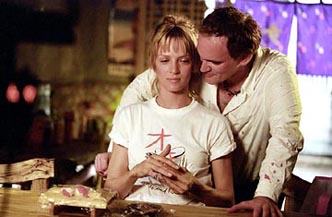Chapter Two: Kill Bill Vol. 2
By Brett Beach
May 20, 2010
This week: The word violence gets used (a lot). Tarantino riffs on revenge, motherhood, and family. Larger cinematic considerations of what it means to lose a child. Breaking up “one” movie into “two”: artistically justifiable or cynically profit-driven?
“Bill, it’s your baby.” --words uttered by The Bride just before she takes a bullet to the head.
Sometime in his lifetime (and I would hope my lifetime crosses over with this event) Quentin Tarantino will make a film where his protagonists just won’t quite get around to killing each other. I want to make clear upfront that this is not a lead-in to an indictment of the violence in his films. As brutal - and comically excessive - as many of these moments are and as feverishly as he stages the action surrounding these moments (particularly the fights in Kill Bill Vol. 2) with the aid and abetment of his longtime editor Sally Menke, the cost of the violence to his characters’ souls is always there in the sub/text.
Whether it is Jules Winnfield’s sudden decision to shed his hit-man mantle and “walk the earth”, Max Cherry’s weary resignation to grow old in his seedy profession, or Beatrix Kiddo’s resolute path of vengeance nearly undone by the revelation that her daughter is still alive, the cost of their violent ways or of the company they keep can’t be charged to life’s bar tab forever.
I have no doubt that in this rhetorical film, the threat of violence will hover in the air, explicitly and implicitly, as it does in all of his creations, but my thinking is that the characters will talk each other to death (ha ha) or they will enjoy the conversation too much to allow it to come to any sort of (final) resolution. Just as many of Raymond Carver’s stories resonate with the sense of an impending doom yet only a few actually build to a physically violent climax, Tarantino’s talking heads always seem on the verge of eventually lashing out at one another. Every tête-à-tête seems rife with the possibility that someone may end up losing his or her tête. And yet the words they wield as skillfully as weapons are so intricate and seductive and often pleasurable that it’s not inconceivable that they might not want to shut up.
These exchanges precede violence, postpone violence, and circle around violence. A love of language(s), storytelling and the gift of gab drives many of his characters and it amazes me how fresh Tarantino keeps the formula considering the number of times he employs it. A perfect example is this exchange between Stuntman Mike and Pam in Death Proof as he gives her a ride home:
“Well, Pam, which way you going, left or right?”
“Right.”
“Oh, that’s too bad...”
“Why?”
“Because it was a 50/50 shot on whether you’d be going left or right. You see, we’re both going left. You could have just as easily been going left, too. And if that was the case, it would have been awhile before you started getting scared. But since you’re going the other way, I’m afraid you’re going to have to start getting scared..immediately.”
Continued:
1
2
3
|
|
|
|




